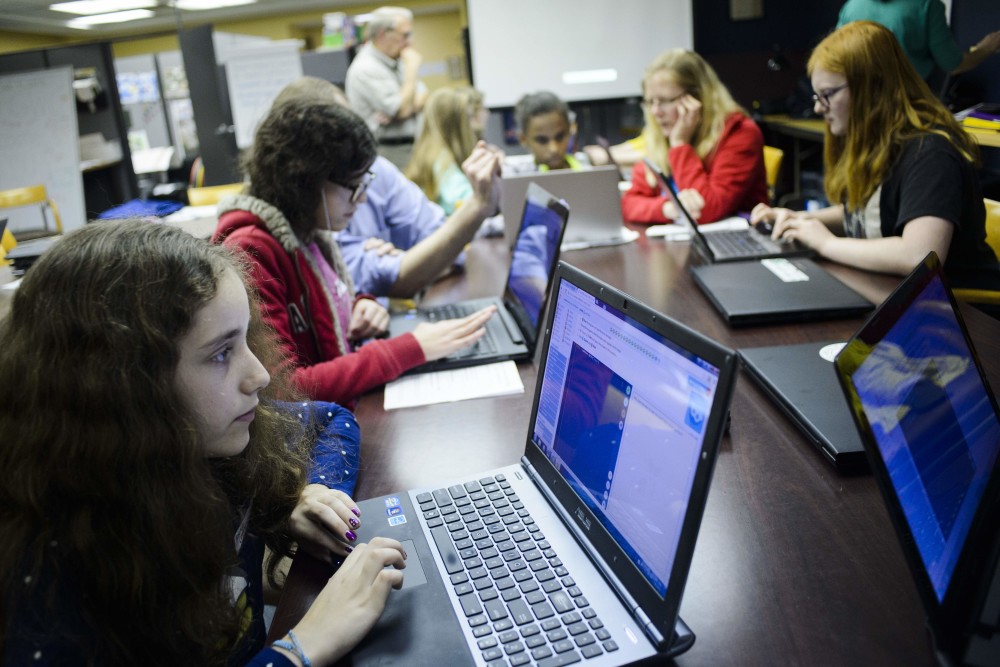By Ryan Quinn
The Charleston Gazette, W.Va.
WWR Article Summary (tl;dr) Empowering women and girls in STEM is the focus of a new coding program offered by the local 4-H in Charleston, West Virginia. The new girls-only coding class teaches young women how to code using the online Codesters program. The hope is to spark female interest in the male-dominated computer science field and close the gender gap.
West Virginia
It was only the second in-class session. “Get boring administrative stuff out of the way” was on the agenda, and the girls were rather quiet sitting around the table at the West Virginia University Extension Service office earlier this month.
Sherry Swint, a WVU Extension 4-H agent at the Kanawha City location, asked the girls for name suggestions for their group, which is learning to code in mostly weekly sessions that started last month and are scheduled to run through June. Jeannette Bombardiere, 12, gave the first suggestion: Pixel Girls.
“Oh my god,” said Emma Gardner, a 4-H volunteer, in an apparent epiphany. “Pixel Pixies.”
Skylar Treadway — who, during group introductions, said video games were her interest before returning to playing one on her phone — suggested some sort of pun on Digimon, a anime media franchise of evolving digital monsters separate from the wider-known Pokemon. The 11-year-old DuPont Middle student eventually suggested Digigirls.
“Pixelated Cats, Pixelated Kittens” added Jeannette, a Horace Mann Middle student.
“I think we get that pixel thing, I want to hear other people,” replied Ysabel Bombardiere, the class instructor and Jeannette’s mom. Skylar later added Digidragons to the recommendations.
For the time being, Ysabel moved on from the club name without a decision. Class rules were then solicited and decided. Yes, they could listen to music using headphones. Food was allowed, though Darcy Witt, 12, of Andrew Jackson Middle, noted the danger of liquids near computers, recalling that her friend spilled coffee on his computer when he jumped at a horror video game.
“I wonder if it was running on Java,” Skylar quipped.
The girls eventually got down to coding on their laptops. They weren’t yet on the Java programming language, but on one called Python. Using the online Codesters program, they logged onto a curriculum Ysabel said was customized particularly to spark female interest in the male-dominated computer science field.
The New York City-based nonprofit Girls Who Code helped provide the specialized Codesters program, part of the new girls-only coding classes provided by the local 4-H. Ysabel said 15 girls signed up for the free program, and all are middle-schoolers save for one high-schooler.
A 2013 report analyzing data from the U.S. Census Bureau’s 2011 American Community Survey found that while women’s representation in all science, technology, engineering and math fields has increased since the 1970s, they remain “significantly underrepresented” in the two areas that comprise 8 out of 10 STEM jobs: engineering and computer occupations.
The report also noted that most of the growth in female STEM employment for women under 40 occurred from 1970 to 1990, and that rate has slowed since then. Since the 1990s, the percentage of women actually declined in computer occupations, which themselves make up about half of all STEM jobs.
“In a room of 25 software engineers, right now we have only three women,” Ysabel said. “So we are using half of the brain to design all of our websites, apps, games — so we’re losing a lot of brainpower by not being more diverse.”
For some problems, the girls were tasked with changing the computer language to place dots at certain points on a coordinate plane. In other problems, they dragged pre-written lines of code into a box to change an on-screen animation of a fox or another creature, making it move one way or another. At one point, the program asked Jeannette to click on the fox.
“I’m a fox,” the on-screen mammal stated in a dialogue box.
“You don’t say,” Jeannette replied. Darcy, amid debugging bits of code and re-running the animations to ensure they were correct, made the fox say her name instead.
Some parents attended the meeting, including some who helped or observed the girls. Susanne Coffield said her 11-year-old daughter, Rachel, was interested partly because of her older brother’s coding interest.
“For girls, making pictures and making them move and talk and all that, it’s definitely right up their alley for most of them.” Coffield said of the program.
Ysabel said the program helps students learn through doing.
“They see what happens, and then they get the structure in their mind of how a program has to work, and then it’s easier for them to write,” she said. “… When they write it, it’s like they already know the language.”
She said registration is closed until August. For more information, contact Sherry Swint, the 4-H agent, at sherry.swint@mail.wvu.edu or 304-720-9573.














































































































































































































































































































































































